This is the Future of Pickup Trucks
Meet Rivian, the billionaire-backed startup behind the first electric pickup and SUV built for weekend escapes.
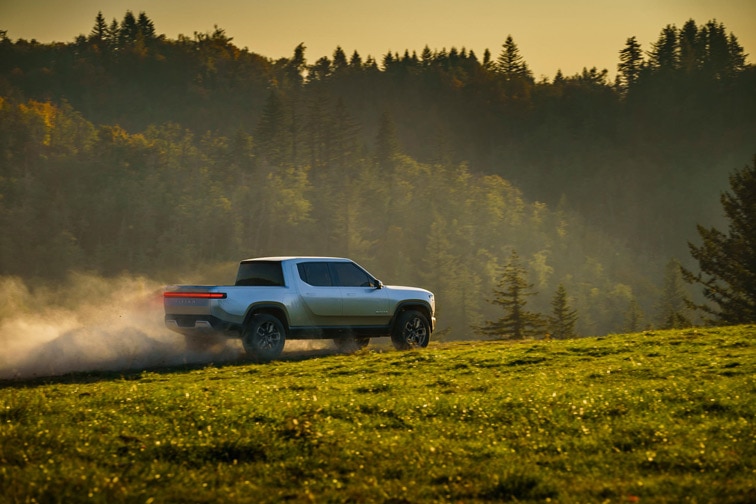 Rivian
Rivian
If you’re the type of person who thinks any pickup truck worth its salt should possess prodigious power, tow over 10,000 pounds and cross rivers with impunity, read on. If you’re the type who would rather have a nice vehicle that minimizes your carbon footprint and makes your trip to the grocery store as stress-free as possible, well, read on.
What you’re looking at is the Rivian R1T pickup: It’s 100% electric, boasts a 400-mile range, can go from 0-to-60 in 3.0 seconds and tow 11,000 pounds.
And no one outside the company has seen it. Until now.
Rivian spent the better part of the past decade creating a truck designed to transform your weekend road trip into an off-the-grid escape. (It has also designed a seven-passenger, three-row SUV that shares most of the same attributes as the R1T.) The company flew us to its headquarters in Detroit for a deep dive on the fruit of their labors and a rare glimpse into the future.
 Rivian
Rivian
Why haven’t I heard of Rivian?
The auto industry is littered with failed startups, and for every Tesla there are a dozen
However, engineers, designers and marketers have spent that time collaborating on not only the next generation of EVs, or electric vehicles, but an entirely new brand to go with them… all behind closed doors. That’s because there’s a key difference between Rivian and companies like DeLorean and Fisker, which were led by legendary (and eponymous) car designers with an eye for style but less-than-perfect business acumen. Rivian’s founder is Dr. R.J. Scaringe, a 30-something with a more-than-passing
In Case You’re Wondering: Scaringe grew up near Florida’s Indian River, from which Rivian takes its name.
Rivian boasts a design and engineering HQ in Detroit, two technical centers in Silicon Valley and an ex-Mitsubishi factory in Normal, IL. Throw in a team of engineers and designers hand-picked by Scaringe—including more than a few of the engineers responsible for the renowned supercars from McLaren, one of the designers behind the Jeep Wrangler, and a manufacturing manager that used to oversee Mercedes and Hummer production—and Rivian already has in place much of the infrastructure and talent needed to succeed in actually producing its vehicles.
Production is slated to start within two years, and they’ll be sold via a direct dealer model similar to Tesla. Each Rivian will come with a full suite of advanced driving aids, including self-driving capabilities on the highway, and you can expect a base price starting in the neighborhood of $60,000.
That’s all background, though. The vehicle is what matters.
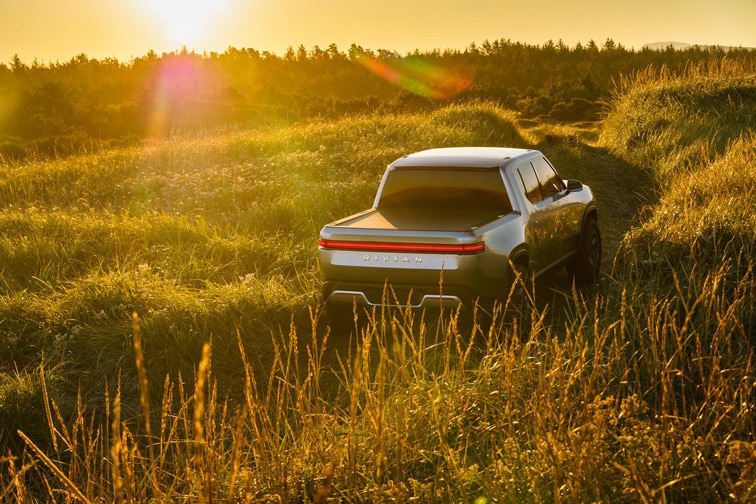 Rivian
Rivian
To really appreciate Rivian’s attention to detail, you have to use it
Scaringe likens Rivian to brands like Patagonia and Land Rover, upscale, aspirational products that incorporate a do-anything practicality at their core. In his words, they “invite” you to do the activities you like. In the R1T, that equates to innovative designs meant to “surprise and delight” owners, as well as high-end tech and visual style elements.
Practical Engineering You Never Knew You Needed
Rivian’s emphasis on storage, unexpected features and easy maintenance is hard to miss in the R1T.
It starts up front, with a power frunk (front trunk) that lifts itself to reveal 11.7 cu.ft. of cargo space, not to mention eight hooks for tying down your belongings. There’s extra storage under the rear seats, which fold forward to reveal 3.4 cu.ft. of space, and even more under the truck bed. The real party piece of the R1T’s storage capabilities, though, is a storage “tunnel” that runs horizontally behind the cab. Yes, it’s actually a tunnel, the kind that is perfect for fitting a set of skis or a few duffel bags. You want innovation? The tunnel doors open flat, like a seat or even a step built right into the side of the truck, and they’re engineered to withstand up to 400 lbs.
Rivian’s designers are proud of what they like to call features “you never knew you needed.” There’s not one, but three different 110a power outlets to satisfy all your
Inside, material choices are made out of only the most practical considerations. The seat coverings are a high-end polyurethane (Rivian calls it “vegan leather”), chosen for its durability. Everything is meant to not just be easily cleanable, but to resist showing every spec of dirt deposited by your shoes. Such was the team’s self-professed passion about flooring that they devised a “mustard and ketchup” test, wherein America’s most popular condiments were smeared onto fabric samples, which then had to come perfectly clean.
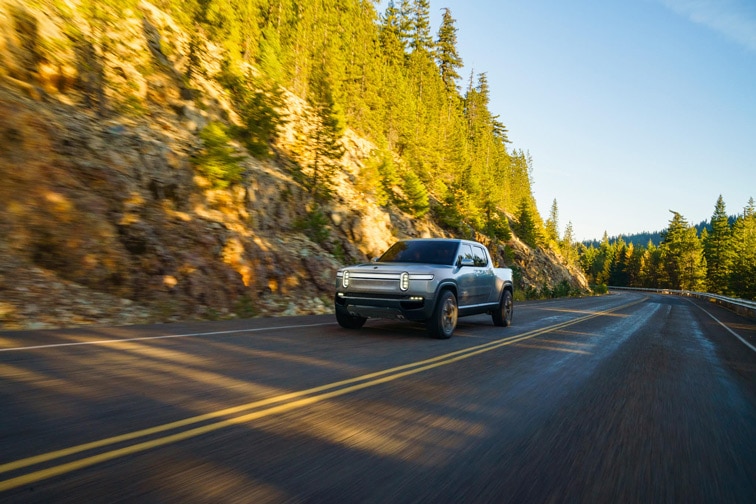 Rivian
Rivian
Aspirational Design, or Rivian in the Rearview Mirror
For all of the thought that went into how the R1T will hold up to everyday events like grocery store runs and tailgate parties, it’s the tech and style that make it stand out from the rest of the parking lot.
The technology is visible from the moment the headlights turn on. Two oval headlights—nicknamed “stadium lights” for their obvious sporting shape—are connected by a solid bar of light running the entire width of the truck; it should be instantly recognizable as a Rivian in any rearview mirror. Across the tailgate is the same bar, but it’s red and doubles as a charge indicator that informs owners of the battery charge when they approach. Hop inside, and a 15.3” touch-screen display dominates the center of the dashboard, and is accompanied by a 12” LED instrument panel. Even the rear-seat A/C controls are touch-screen.
As for the actual sheet metal, the team wanted to build a truck that can be defined by just three lines. It looks more simple than it is, with a short bed, full cab and an uptick at the rear of the side windows derived from German sports sedans. Subtle elements like two-tone badging on the sides and carbon-fiber inserts on the wheels underscore the detail-oriented approach.
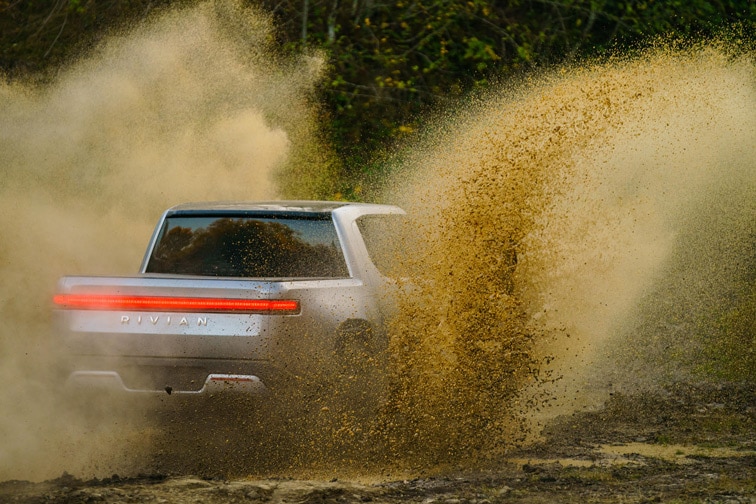 Rivian
Rivian
Quicker than a sports car, more versatile than a pickup?
To be successful, a truck has to be able to perform under duress and, fortunately for Rivian, that’s arguably the R1T’s strongest suit.
In the overall automotive landscape, Rivian sits somewhere between Tesla and Land Rover, with just a splash of Subaru and McLaren. At his headquarters, a prideful Scaringe points to a photo of the R1T blasting down a dusty desert trail and boasts that dirt, “is our Porsche-on-a-race-track moment.” (Alas, our preview of the R1T did not include a test drive.)
But as with the layout and design, the R1T’s performance is a mix of practical and aspirational.
Enough technology to help you get lost (deliberately)
The Chevrolet Bolt EV, known for having a great electric range, features a 60 kWh battery pack and can go 237 miles on a single charge. For the sake of comparison, a Tesla Model S can be ordered with up to a 100 kWh battery, good for up to 335 miles of range. Rivian’s largest battery pack will be a 180 kWh unit capable of a 400 mile range. That’s a big leap—not to mention enough range to get from Los Angeles to Death Valley and (crucially) back again—and it does it via three very different, very advanced technologies:
- A proprietary “intelligent battery management system” effectively learns driver habits and adjusts accordingly. The system can also take into account elevation changes along a pre-planned route and better control the system’s charge, and it constantly updates via cloud-based software.
- A thermal management system cools (and heats) the battery pack to keep it within an optimum temperature range. If batteries get too hot or too cold, they lose efficiency, so Rivian developed an in-house “chiller” unit, then tested it extensively in the Arizona desert using their platform disguised under a Ford F-150 body.
- Aerodynamics: Just as the R1T can lower for easier entry, it can lower on the highway as well, helping it slice through the air more easily and thus improving efficiency. Combined with other details like that power tonneau cover, the R1T is, according to Rivian, anyway, “the world’s most aerodynamic truck.”
Even when the batteries do need a recharge, it shouldn’t take long: 15 minutes on a standard fast charger, is good for 100 to 150 miles of range, and 50 minutes should net an 80% charge.
Of course, charge times only matter if you’re anywhere near a charger, and part of the purpose of this truck is to get you very far away from civilization. That’s why the company’s plan is to begin to build out a charging infrastructure in the places where you’re least likely to see an outlet, like Joshua Tree, Calif.
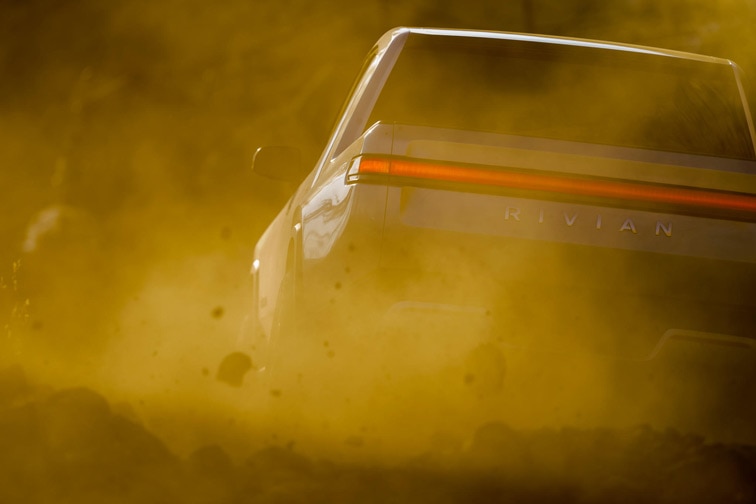 Rivian
Rivian
Power and performance go above and beyond. Literally.
It’s hard to emphasize just how important range is, but it’s kind of like milk: it tends to go unappreciated until you start to run out. Power and performance, however, bring the kind of sizzle that whets virtually any appetite. With world-class acceleration and what has all the makings for fantastic handling—both on and off-road, Rivian looks to have done its homework.
With four motors (one per wheel), putting out a combined total that’s well in excess of 700 hp, Rivian says the R1T can go from a standstill to 60 mph in a supercar-quick three seconds. It also has enough torque (over 800 lb.ft.) to tow up to 11,000 lbs.: hardly entry-level truck material. If you want that kind of towing capacity on any truck on the market today, be prepared to shell out for heavy duty towing packages.
When it comes to handling, the battery packs offer a few natural advantages over an internal combustion engine in terms of where the weight is located in the vehicle. That should translate to better agility, because the suspension has to work less to make the truck change directions.
Speaking of suspension, Rivian’s engineers created a setup that bears almost no resemblance to anything you’ll find on a regular pickup truck. If anything, picture a BMW M5’s suspension, with a touch of the exotic. All those McLaren engineers Rivian hired? There’s a very advanced hydraulic system built into the suspension that bears a strong resemblance to the quarter-million dollar supercars. The bottom line is that when the suspension needs to be stiff, say, to support a 1,760-lb. payload in the bed, it can, but it can yield a plush ride the rest of the time.
That also means there’s more capability offroading. Combined with longer axles than vehicles sporting a traditional engine and transmission, the R1T’s wheels are allowed greater travel up and down, and according to Rivian’s engineers can thus remain in contact with the ground over a greater range of rough terrain than something like a Range Rover.
Combined with the aforementioned variable-height air suspension, the R1T can go from a respectable 8.8 inches of ground clearance all the way to 14.1 for its most intense off-road setting. It can climb hills up to a 45-degree angle, and because it uses a quartet of electric motors, it can adjust the power to each wheel independently and instantaneously, even reversing one wheel if that’s what it takes to clear an exceptionally challenging patch of terrain.
Find a shallow stream? R1T can cross it: any water up to a meter deep is no problem. According to Rivian’s engineers, the cabin is water tight, and the only thing preventing the truck from being able to drive under water is a pesky thing called buoyancy.
How is this EV startup different from all other EV startups?
It’s too early to say whether Rivian will join the rare ranks of successful startup carmakers or if it will go down in history as a 21st century Tucker, but there are reasons for optimism.
Scaringe’s background means he understands the complexity of mass production. While some other startup manufacturers have had difficulty meeting production quotas, Rivian chose the Detroit area as its HQ because you “can’t walk away from” 120 years of manufacturing knowledge.
That knowledge has already borne fruit, with manufacturing engineers and the design team working together to find practical and cost-effective solutions that can be readily produced.
To be certain, Rivian won’t replace the pickup mainstays that boast generations-old brand loyalties. But for younger buyers with an appreciation for tech and no affinity for one particular truck brand, it should be a viable option. From the design and engineering of the body to the technical and performance prowess of the chassis, almost every aspect of the pickup contributes to the practical pursuit of otherwise impractical passions. Simply, it’s built to get you through the work week, so that it can take you virtually wherever you need to go to recharge your batteries, without needing a charge of its own.
Written by humans.
Edited by humans.
 Aaron Miller
Aaron MillerAs a veteran automotive journalist, I have been fortunate enough to drive some of the most desirable cars on the planet and get to know some of the most important people in the industry. Before joining Capital One, I served as the Cars Editor for a major national website, and covered industry news and analysis for well-known automotive-specific sites. I also wrote feature articles and reviews for niche enthusiast websites. I’ve been obsessed with cars since—literally—before I can remember, with my collection of die-cast and slot cars taking center stage during my formative years. Simply put, for me, working isn’t really “work.”
Related articles
View more related articles